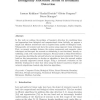Free Online Productivity Tools
i2Speak
i2Symbol
i2OCR
iTex2Img
iWeb2Print
iWeb2Shot
i2Type
iPdf2Split
iPdf2Merge
i2Bopomofo
i2Arabic
i2Style
i2Image
i2PDF
iLatex2Rtf
Sci2ools
113
Voted
IJON
2008
2008
Computational analysis and learning for a biologically motivated model of boundary detection
In this work we address the problem of boundary detection by combining ideas and approaches from biological and computational vision. Initially, we propose a simple and efficient architecture that is inspired from models of biological vision. Subsequently, we interpret and learn the system using computer vision techniques: First, we present analogies between the system components and computer vision techniques and interpret the network as minimizing a cost functional, thereby establishing a link with variational techniques. Second, based on Mean-Field Theory the equations describing the network behavior are interpreted statistically. Third, we build on this interpretation to develop an algorithm to learn the network weights from manually segmented natural images. Using a systematic evaluation on the Berkeley benchmark we show that when using the learned connection weights our network outperforms classical edge detection algorithms. Key words: Computer Vision, Biological Vision, Neural...
Related Content
| Added | 12 Dec 2010 |
| Updated | 12 Dec 2010 |
| Type | Journal |
| Year | 2008 |
| Where | IJON |
| Authors | Iasonas Kokkinos, Rachid Deriche, Olivier D. Faugeras, Petros Maragos |
Comments (0)

